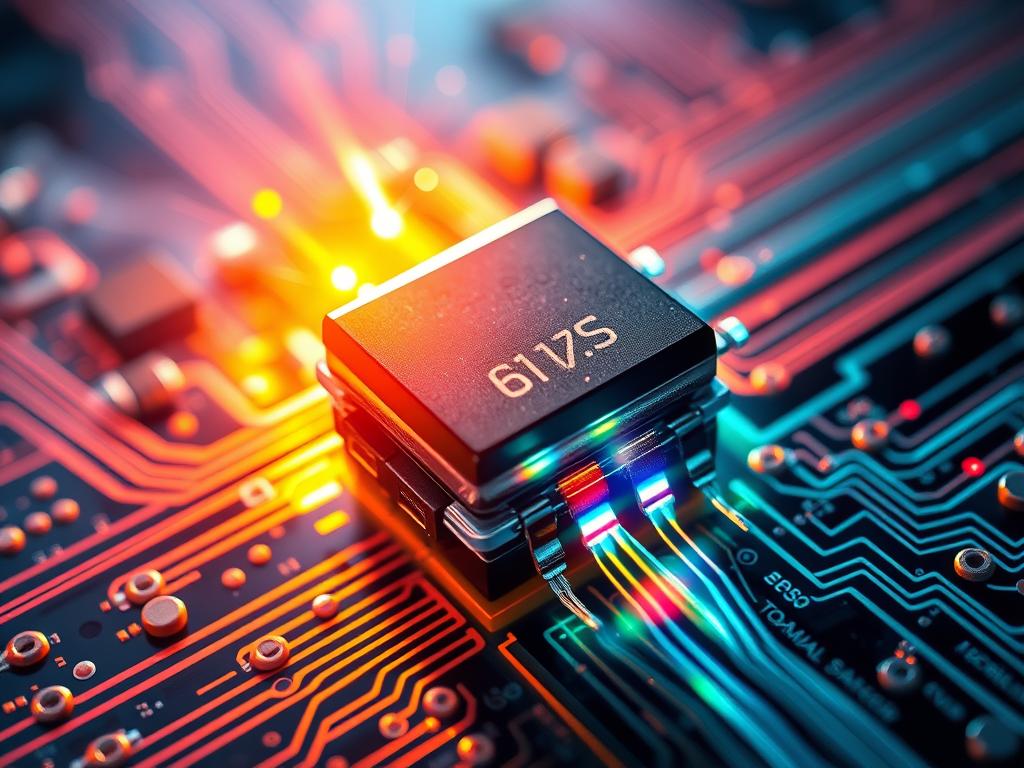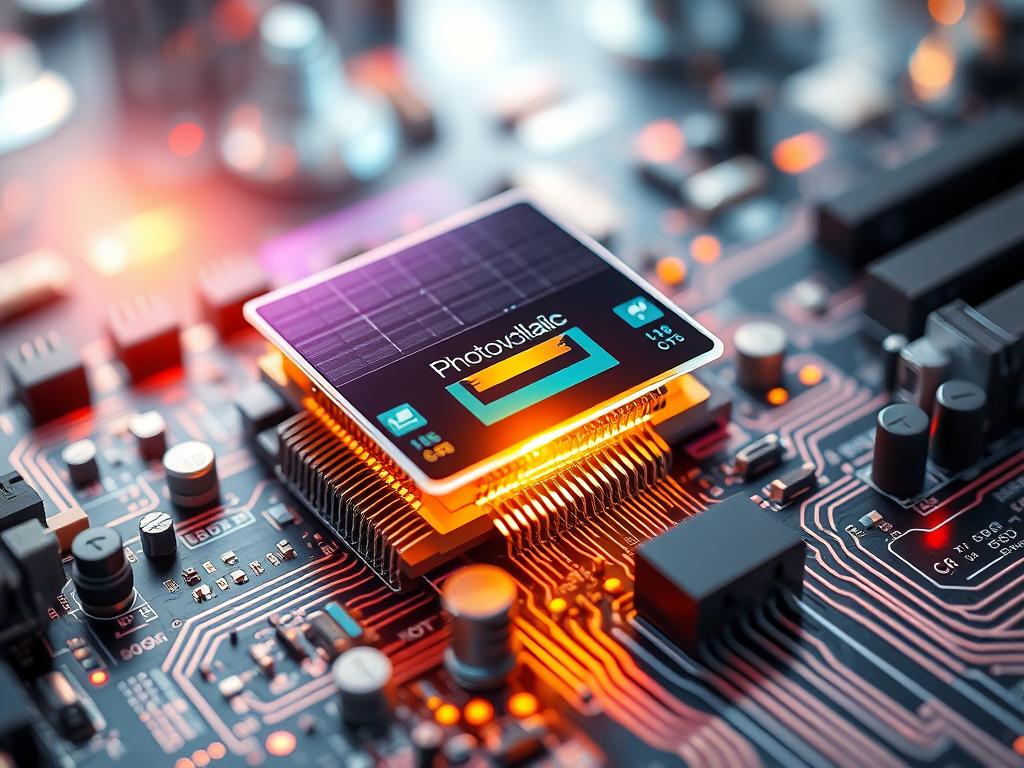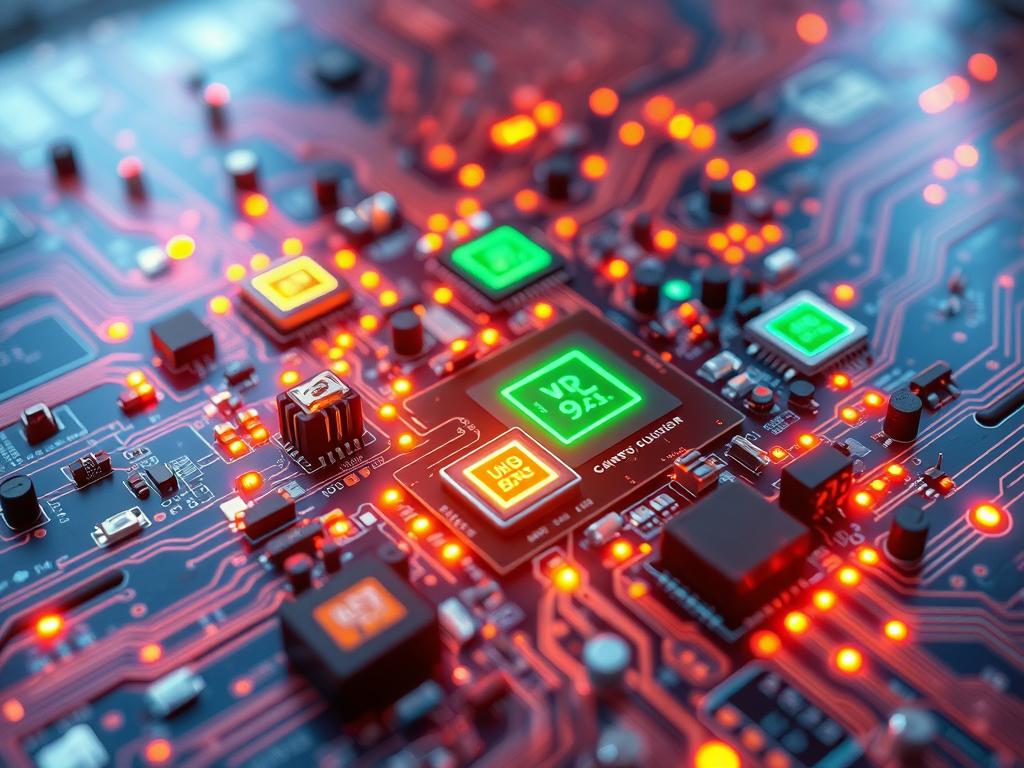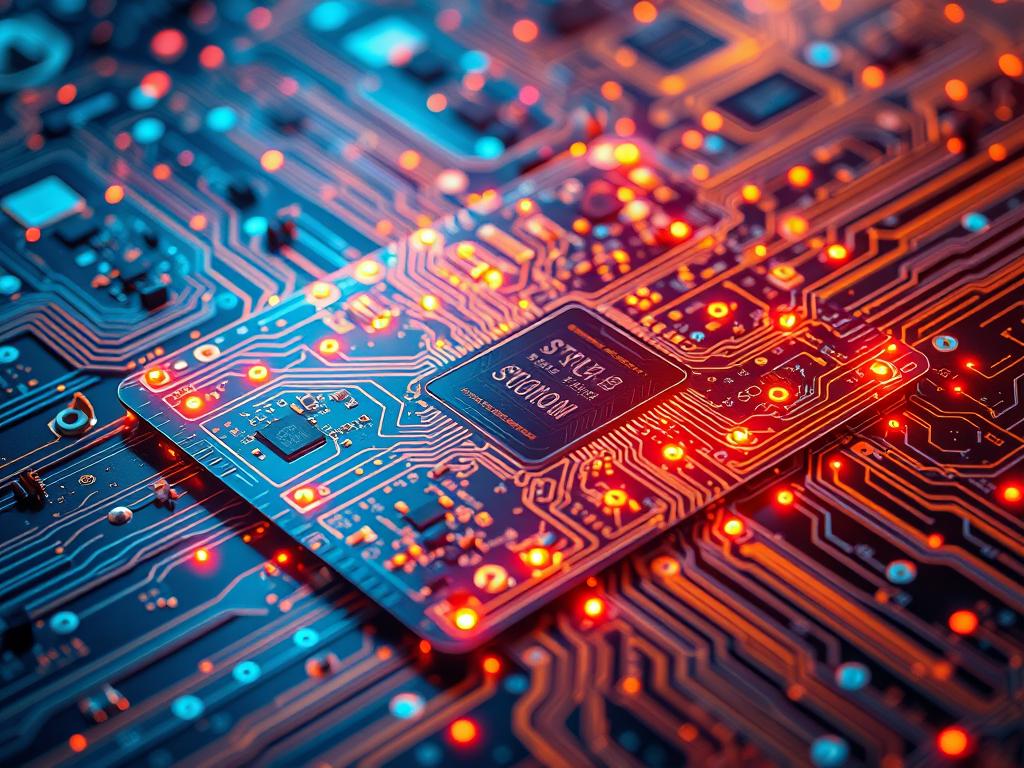Photovoltaic transistors are new devices that mix solar energy with semiconductor tech. They are a big step forward in using renewable energy in electronic circuits. These transistors turn light into electricity and work like regular transistors. This makes it possible to have self-powered electronics and improve energy use in many areas.
Key Takeaways
- Photovoltaic transistors integrate solar energy harvesting into electronic circuits, enabling self-powered and energy-efficient systems.
- These devices can simultaneously convert light into electricity and perform traditional transistor functions.
- Photovoltaic transistors contribute to the development of sustainable electronics and green computing technologies.
- Advances in semiconductor materials and manufacturing processes are driving the evolution of photovoltaic transistors.
- Photovoltaic transistors have the potential to transform how we power and integrate renewable energy into electronic devices and systems.
Introduction to Photovoltaic Transistors
Photovoltaic transistors are special semiconductor devices. They combine the functions of a solar cell and a transistor. These devices can turn sunlight into electrical power right in electronic circuits. This means you don’t need separate solar cells and power management parts.
This integration makes for more compact, efficient, and versatile energy harvesting devices. They use the power of renewable photovoltaic cells.
What Are Photovoltaic Transistors?
Photovoltaic transistors are semiconductor devices that can make electricity from light. They don’t need extra circuitry like traditional solar cells do. This lets them control electrical current in a circuit using the photovoltaic effect.
This way, they help create compact, lightweight, and efficient renewable power sources. These can be used in many electronic applications.
How They Work in Solar Energy Applications
- Photovoltaic transistors absorb light energy and turn it into electrical current, like traditional solar cells.
- But, they can also control and regulate the flow of this electricity in a circuit. They act as both a power source and a switching/amplifying component.
- This mix of solar energy conversion and electronic control makes for highly efficient, self-powered systems. These systems can run directly from sunlight, without needing big or complex power management setups.
The combination of photovoltaic and transistor functions in one device opens up new possibilities. It allows for the creation of advanced energy harvesting devices. These devices can use renewable solar power more effectively and efficiently.
The Science Behind Photovoltaic Transistors
Photovoltaic transistors work through a cool scientific process called the photovoltaic effect. This happens when materials like silicon or gallium arsenide soak up light and make electricity. When light hits these materials, it kicks out electrons, creating pairs that can power circuits.
Semiconductor Materials Used
These transistors use special materials to turn light into electricity. These materials are great because they:
- Soak up a lot of light
- Make lots of electron-hole pairs when hit by photons
- Help control and grow the electric current
Scientists are always working to make these materials better. This could lead to even more efficient Low-Power Circuit Design, Self-Powered Systems, and Eco-Friendly Semiconductors.
Mechanisms of Light Absorption and Conversion
The photovoltaic effect in these transistors is quite complex. When light hits the material, it moves electrons from one band to another. This creates pairs of charges that are then split and sent through the transistor. This makes an electric current that can power devices.
How well this works depends on the material, the design of the transistor, and research to improve it. By understanding this science, experts can keep making Low-Power Circuit Design, Self-Powered Systems, and Eco-Friendly Semiconductors better.

“The photovoltaic effect is a fundamental process in nature that converts light energy into electrical energy. This process is the foundation for the development of photovoltaic transistors, which have the potential to revolutionize the way we power our electronic devices and systems.”
Types of Photovoltaic Transistors
In the world of green tech, photovoltaic transistors are key for using solar power in circuits. They come in two main types: organic and inorganic photovoltaic transistors.
Organic Photovoltaic Transistors
Organic photovoltaic transistors use carbon-based materials. They are flexible and can be made cheaply. These are great for bendable or light solar devices, like wearables or flexible screens.
The materials used, like polymers, are easy to work with. This makes them a top pick for solar energy integrated into circuits and Sustainable Electronics.
Inorganic Photovoltaic Transistors
Inorganic photovoltaic transistors are made from silicon or other materials like gallium arsenide. They are more efficient and last longer than organic ones. This makes them perfect for high-performance uses.
They are used in big solar projects, like those in industry, space, and for grid-scale systems. Their reliability and efficiency are key here.
“The development of photovoltaic transistors has been a game-changer in the field of sustainable electronics, paving the way for a future where solar energy is seamlessly integrated into our everyday devices and systems.”
As we look for more green energy, photovoltaic transistors are vital. They help us move towards a greener future in sustainable Electronics.
Advantages of Using Photovoltaic Transistors
Photovoltaic transistors bring big benefits in energy use and fitting with current tech. They turn light into electricity right in the circuit. This cuts down on energy lost during sending, making them better than old power sources.
Enhanced Energy Efficiency
Photovoltaic transistors convert solar energy into electricity right away. This means no extra steps are needed to get power. This Green Computing and Energy Harvesting Devices combo boosts system efficiency. It also lowers energy use in many areas.
Integration with Existing Technologies
These transistors work well with lots of tech, from wearables to solar panels on buildings. They make these systems work better and more efficiently. This lets them run on their own, without needing outside power.
| Metric | Value |
|---|---|
| Solar Radiation (EJ/year) | 3,800,000 |
| PV Cell Conversion Efficiency | 22.5% |
| PV Capacity Installed (GW) | 177 |
Adding photovoltaic transistors to electronics boosts energy use and makes tech more sustainable. They’re becoming a key choice for many uses.
“Photovoltaic cells turn solar power into direct current electricity. This is key for solar systems on or off the grid, improving energy security during power outages.”
Applications in Solar Energy Systems
Photovoltaic transistors are key in making solar energy systems better. They help make solar power more efficient and open up new uses. These transistors lead the way in using Photovoltaic Cells and Renewable Power Sources.
Role in Solar Panels
In solar panels, photovoltaic transistors boost energy conversion. They do this by combining power generation and control in one chip. This makes solar panels work better, capturing more sunlight and increasing their performance.
Integration with Smart Grid Technologies
Photovoltaic transistors are also vital for linking solar energy with smart grids. They manage power in real-time, making it possible for solar homes or buildings to send and receive electricity. This is key for a smarter, more reliable energy system.
Uses in Consumer Electronics
Photovoltaic transistors are also in consumer electronics. They help make devices that can charge themselves using sunlight. This means devices might not need batteries, making them more eco-friendly.
| Application | Benefits of Photovoltaic Transistors |
|---|---|
| Solar Panels | Improved energy conversion efficiency, integrated power generation and control |
| Smart Grid Integration | Enabling real-time power management, facilitating bidirectional energy flow |
| Consumer Electronics | Self-charging devices, reduced dependence on batteries |
“Photovoltaic transistors are changing how we use solar energy. They help in big power systems and small devices. These devices are leading us to a greener, more efficient energy future.”
Challenges Facing Photovoltaic Transistors
Photovoltaic technology is getting better for use in electronic circuits and systems. But, there are big challenges to overcome. The main ones are the cost and production, and how stable and long-lasting these transistors are.
Cost and Production Issues
One big problem is the high cost of making photovoltaic transistors, especially for efficient materials. It’s hard to make more while keeping quality and performance the same. Low-Power Circuit Design and Self-Powered Systems need cheaper ways to make them. This is an area where more research and new ideas are needed.
Stability and Longevity
Another big worry is how long photovoltaic transistors last and how well they work over time. Especially for organic ones, they need to handle different environments and keep working for a long time. Making them stable and lasting is key for Low-Power Circuit Design and Self-Powered Systems to be used more widely.
| Metric | Value |
|---|---|
| Solar radiation per year | 3.8 million EJ |
| Photovoltaic cell efficiency | 22.5% |
| Global PV capacity installed in 2013 | 100 MW/day |
| Total global PV capacity | 177 GW |
By tackling these challenges and pushing the limits of photovoltaic transistor tech, we can make them better for Low-Power Circuit Design and Self-Powered Systems. This will help us move towards a greener and more energy-efficient world.

Future Trends in Photovoltaic Transistors
The future of photovoltaic transistors looks bright, thanks to advances in material science and solar technology. As more people seek eco-friendly semiconductors and solar energy solutions, scientists and engineers are exploring new possibilities. They aim to make these devices even better.
Advances in Material Science
Researchers are focusing on finding new materials for photovoltaic transistors. These materials should be more efficient and cheaper to make. For example, perovskite-based photovoltaics could be a game-changer, offering high performance at lower costs than silicon.
Also, multi-junction solar cells are being developed. These cells stack different layers to absorb more light. This could lead to even better energy conversion rates.
The Growing Market for Solar Technology
The demand for solar technology is skyrocketing. This is due to growing environmental concerns, government support, and the need for renewable energy. This boom is driving more research and investment in photovoltaic transistors.
These transistors are being used in more ways than just solar panels. They’re being integrated into buildings and even IoT devices. This opens up a world of possibilities for using solar energy in our daily lives.
As the industry grows, Eco-Friendly Semiconductors and solar energy integrated into circuits will be key. They will help create a more sustainable and efficient future. With ongoing research and market growth, photovoltaic transistors are set to play a big role in our greener future.
“The future of photovoltaic transistors is not just about increasing efficiency, but about seamlessly integrating solar energy into the very fabric of our daily lives.”
Photovoltaic Transistors vs. Traditional Solar Cells
In the world of Sustainable Electronics and Green Computing, photovoltaic transistors stand out. They have a unique edge over traditional solar cells. Photovoltaic transistors are better for small, self-powered systems.
Comparative Efficiency
Monocrystalline silicon cells are very efficient, losing power slowly over time. Polycrystalline silicon cells are also efficient, but not as much as monocrystalline. Heterojunction technology combines these to make cells that are both efficient and affordable.
Design and Integration Differences
Photovoltaic transistors are designed to fit well in electronic circuits. This makes systems smaller and simpler. They are great for consumer electronics and smart grid technologies.
Bi-facial cells also offer more energy and cost savings. They can make more energy from a smaller area than other cells.
| Solar Cell Type | Efficiency | Advantages | Disadvantages |
|---|---|---|---|
| Monocrystalline | Typically 15-22% | High efficiency, slow degradation | Relatively higher cost |
| Polycrystalline | Typically 15-16% | Cost-effective | Lower efficiency than monocrystalline |
| Heterojunction | Higher efficiency, lower cost | Combines crystalline and thin-film technologies | More complex manufacturing process |
| Bi-facial | Higher efficiency, reduced costs | Increased energy generation per area | More expensive than traditional cells |
“The aim across generations is to reduce costs and enhance efficiency; calculations and feasibility assessments are crucial before designing a PV system.”
The Sustainable Electronics and Green Computing fields are growing. Photovoltaic transistors bring new benefits in power and control. They work well with traditional solar cells.

The Role of Nanotechnology
Nanotechnology changes how we make Energy Harvesting Devices and Photovoltaic Cells. It’s a new science that could make solar energy better. This could start a new chapter in solar power.
Impact on Photovoltaic Transistor Performance
At the nanoscale, materials act differently. They can help photovoltaic transistors work better. For example, nano-structured surfaces can catch more light and turn it into energy.
Also, using quantum dots and nanowires could make devices more efficient. These tiny materials can catch a wider range of light.
Potential Innovations through Nano-scale Materials
Nanotechnology and photovoltaic transistors could lead to big changes. Experts think there will be a $1 trillion global market for nanoproducts soon. This could bring new materials and technologies that change how we use solar energy.
“Nanotechnology offers the possibility of introducing technologies that are more efficient and environmentally sound.”
Nanotechnology is growing fast. It will change photovoltaic transistors and solar energy. By using nano-scale materials, we can make energy solutions better and more sustainable.
Environmental Impact of Photovoltaic Transistors
Photovoltaic transistors are key in cutting down the carbon footprint of gadgets. They make it easier to use solar energy more efficiently. These advanced parts bring solar power right into our devices, cutting down energy use and making our environment greener.
Low Carbon Footprint
Adding photovoltaic transistors to devices boosts energy efficiency and cuts down on harmful emissions. They turn sunlight into electricity, reducing the need for other power sources. This helps lower our carbon footprint, fitting with the world’s push for Renewable Power Sources and Eco-Friendly Semiconductors.
End-of-life Disposal Considerations
Photovoltaic transistors offer big environmental benefits, but we must think about how to dispose of them when they’re no longer needed. Some might have rare or harmful materials that need special care. Scientists are working on making these parts recyclable and biodegradable, ensuring they’re good for the planet in the long run.
“The introduction of nanostructures like Quantum-Dots (QDs) and Nanowires (NWs) has significantly contributed to increasing the efficiency of solar cells over the past few decades.”

As we focus more on being green and protecting our planet, photovoltaic transistors become even more important. By tackling how to handle them at the end of their life and using new materials, this tech has a big role to play in our future. It’s all about making our world more Renewable Power Sources and Eco-Friendly Semiconductors friendly.
Case Studies of Successful Implementation
Photovoltaic transistors have led to new solar circuit projects and more companies using this tech. These examples show how solar energy can be directly used in devices and systems.
Innovative Solar Circuit Projects
One example is self-powered sensors for smart buildings. These sensors use photovoltaic transistors to get energy from light, so they don’t need batteries. This makes them work without stops, helping smart buildings work better.
In wearables, like fitness trackers and smart watches, photovoltaic transistors are used too. They let these devices keep track of activity and health without needing to be charged often. This shows how versatile photovoltaic transistors are.
Corporate Adoption of Photovoltaic Technology
Big tech companies are starting to use photovoltaic transistors in their products. For example, a big phone maker has a phone with a solar display. This phone lasts longer on a charge, which is good for the planet.
Another big company has made a solar keyboard that never needs batteries. This shows how photovoltaic transistors are becoming common in everyday items. It’s a big step towards using less power and being more eco-friendly.
“The integration of photovoltaic transistors has opened up new possibilities for creating self-sustaining electronic systems that can operate without the need for traditional power sources.”
These examples show how photovoltaic transistors can lead to new, green, and efficient solutions. They show the power of combining solar energy with electronics.
Regulatory and Policy Considerations
Photovoltaic transistor technology is getting better, making solar energy in electronics more important. Governments worldwide see its value and are pushing for its use. They do this with incentives and rules.
Government Incentives for Solar Innovations
Many countries give tax breaks, grants, and subsidies for solar research. These help lower the cost of solar electronics. This makes them easier for businesses and people to use.
By supporting solar tech, governments help it grow. This leads to more solar energy integrated into circuits and Sustainable Electronics.
Standards for Solar Integration in Electronics
Policymakers are setting standards for solar in electronics. They focus on energy labels, safety, and how well solar devices work. This ensures solar tech is safe and works well in devices.
These rules help make solar tech more common. They create a clear path for solar energy integrated into circuits and Sustainable Electronics.
| Incentive Type | Description | Example Countries |
|---|---|---|
| Tax Credits | Percentage of solar energy system cost deducted from taxes | United States, Australia, Japan |
| Grants | Direct financial support for solar energy research and development | European Union, China, Canada |
| Subsidies | Ongoing payments to reduce the cost of solar energy generation | Germany, United Kingdom, South Korea |
With government help and standards, makers can use more solar energy in circuits. This boosts Sustainable Electronics in many areas.

Education and Research Opportunities
Universities around the world are creating special programs for green computing and energy harvesting. These programs focus on photovoltaic technology. They teach students how to design and use solar energy solutions.
Research grants from various sources help fund these studies. This funding comes from governments, foundations, and companies. It supports research that improves photovoltaic transistors, leading to a greener future.
Academic Programs Focused on Photovoltaic Technology
- Specialized courses on photovoltaic transistors and their integration in electronic systems
- Interdisciplinary programs combining electrical engineering, materials science, and renewable energy studies
- Hands-on laboratory experiences and project-based learning opportunities
- Opportunities for undergraduate and graduate-level research in photovoltaic technology
Research Grants and Funding Sources
- Government research grants from agencies like the Department of Energy (DOE) and the National Science Foundation (NSF)
- Private foundation funding from organizations focused on sustainability and clean energy innovations
- Industry partnerships with leading technology companies interested in advancing photovoltaic transistor technologies
- Collaborative research initiatives between academic institutions and industry leaders
By supporting education and research, the future of green computing and energy harvesting devices looks bright. Photovoltaic transistors will continue to play a key role.
| Academic Program | Research Focus | Funding Source |
|---|---|---|
| Master of Science in Renewable Energy Engineering | Photovoltaic transistor design and integration | DOE Research Grant |
| Undergraduate Minor in Sustainable Electronics | Developing energy-efficient circuits using photovoltaic transistors | Private Foundation Grant |
| PhD in Materials Science and Engineering | Novel semiconductor materials for high-efficiency photovoltaic transistors | Industry Partnership with Solar Tech Inc. |
“Investing in photovoltaic technology education and research is crucial for a sustainable energy future. By empowering the next generation of engineers and scientists, we can unlock the full potential of green computing and energy harvesting devices.”
Community Projects Utilizing Photovoltaic Transistors
Grassroots solar projects and community efforts are exploring photovoltaic cells and renewable power sources. These projects use photovoltaic transistors to create new energy solutions. They help local people and protect the environment.
Grassroots Solar Initiatives
In rural areas, photovoltaic transistors power off-grid lighting systems. These systems light up communities that were once in the dark. They are a result of partnerships between local governments, non-profits, and tech companies.
Urban areas are also using photovoltaic transistors. Community centers and public spaces are getting solar-powered features. This shows how versatile photovoltaic technology is and how it can fit into our cities.
Collaborative Efforts and Outcomes
| Organization | Project Funding | Cost Share |
|---|---|---|
| Crystal Solar Inc. | $3,000,000 | $3,916,240 |
| Ethical Electric | $1,250,000 | $1,648,525 |
| Kevala, Inc. | $1,762,968 | $2,264,724 |
| Pika Energy, Inc. | $875,000 | $245,000 |
Local groups and tech companies are working together. They’re making public spaces and community services better with photovoltaic transistors. Their success shows how photovoltaic cells and renewable power sources can help our cities and communities.
“The future of solar-powered projects lies in custom configurations tailored to specific device requirements.”
As more people use photovoltaic technology, community projects are leading the way. They’re making our future more sustainable and strong. Photovoltaic cells and renewable power sources are becoming part of our communities.
The Economics of Photovoltaic Transistors
The renewable energy movement is growing fast. This makes the cost-effectiveness of photovoltaic transistors very important. These devices turn sunlight into electricity right in electronic circuits. They could help businesses save energy and be more green.
Cost-Benefit Analysis for Businesses
Businesses need to think about the costs and benefits of using photovoltaic transistors. Low-Power Circuit Design and Self-Powered Systems can cut down energy use a lot. This can make a company’s profits go up.
When looking at costs, businesses should think about making, installing, and how much energy they’ll save. They might also find new ways to make money by adding these transistors to their products. This gives customers cool, self-powered gadgets.
Long-term Investment and ROI
Figuring out the return on investment (ROI) for photovoltaic transistors is key. These devices last a long time and energy costs might go up. This means big savings over the years.
As more people want green tech, adding photovoltaic transistors to products can make a company stand out. It shows they care about the environment.
| Metric | Value |
|---|---|
| Photovoltaic effect observed | As early as 1890 by Henri Becquerel |
| First solar PV device producing usable electricity | Introduced by Bell Labs in 1954 |
| Solar industry efficiency improvement | Consistently increasing over time |
| Reduction in solar cell cost per watt | Significant decrease over the years |
| Global solar installations | Surpassed 1 terawatt in 2022 |
| US solar power generation capacity | Enough to supply over 3% of energy needs |
| Estimated solar energy by 2030 | 600 gigawatts |
| Potential US solar generation by 2035 | 40% of electric demand |
As photovoltaic transistor tech gets better and more people want green energy, businesses can gain a lot. They can save money and lead in the green energy movement.
Conclusion: The Future of Photovoltaic Transistors
Photovoltaic transistors are a big step forward in using solar energy in electronic circuits. They are eco-friendly, efficient, and can power themselves. This makes a solar-powered future more possible.
Summary of Key Benefits
Using solar energy in circuits with photovoltaic transistors could change how we power devices. They make energy use better, cut down on traditional power needs, and lead to greener tech.
Vision for a Solar-Powered Future
As photovoltaic transistors get cheaper and better, they could be used in many things. This includes gadgets, smart buildings, and IoT devices. Using these eco-friendly semiconductors could make our future more green and efficient, with solar power being a big part of it.


